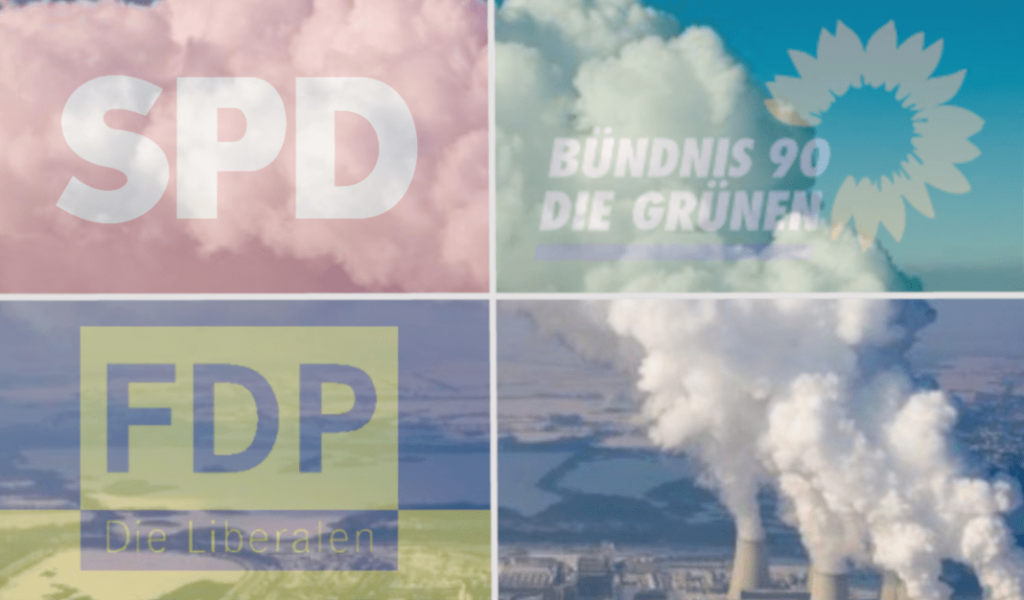Green politics has been around in Germany for almost half a century. Strong public support for environmental policies have put the Green in the federal government between 1998 and 2005, and forced other parties to adopt green policies.
Germany is one of few countries that can point to reductions in greenhouse gas emissions since the 1970s.
The growing electoral support for the Greens and the terrible flooding in July of 2021 ensured that the climate played large part in 2021 federal election campaign. At one point the Green Party was leading in the polls. The high profile Fridays for Future leader, Luisa Neubauer (who is also a Green Party activist), described the election as the “vote of the century”. (https://tinyurl.com/4vseb7m5).
The result of the election was a good one for the Greens, who campaigned on a policy of rapid carbon reduction targets. They won their highest ever percentage of the total votes of any federal election.
Die Linke (The Left), also campaigned on strong carbon reductions, as well as a range of social reforms, but performed disastrously, losing almost half of their previous voter support. The result of a referendum on rent controls in Berlin indicates that although Die Linke’s policies were popular, the party was not able to turn this into votes. They were not helped by the last minute actions of their two main candidate to soften their election platform in the hope of doing a deal with the SDP to be included in the new government.
Fridays for Future’s demands
- At the start of the negotiations between political parties to form the new government, Fridays for Future Germany issued 6 key demands:
- A legally-binding CO2 ‘budget’ that conforms to the Paris Accord’s 1.5C climate targets
- A binding coal phase-out by 2030
- A ban on the installation of fossil combustion engines from 2025
- An immediate stop to motorway and federal highway expansion €14 billion to fund international climate protection measures
- A sevenfold expansion in wind and solar energy
(https://tinyurl.com/59w8rmxk)
But the announcement of the coalition agreement between the SDP, Greens and the pro-capitalist Free Democrats (FDP) was met with immediate criticism from climate campaigners, including Neubauer. There were targets and good intentions, but few concrete plans.
“Ideal” target for coal
The mention of 2030 as a new coal phase-out date (brought forward from 2038) was an acknowledgement of the need to speed up the closing of coal power stations. But this was qualified as an “ideal” target, meaning that it is not a real plan.
Government support for renewable energy was also full of targets and intentions, based on the continuation of a policy to reduce fossil fuel emissions with a government determined price on carbon emissions. (This was not enough to prevent a significant increase in the burning of coal 2021.)
For combustion passenger vehicles, Germany is bound by the EU’s deadline for the production of only CO2 neutral cars as of 2035. A new proposal to advance Germany’s implementation of the EU programme is at present no more than a wish.
There were no new policies to protect workers whose jobs will disappear in the transition away from fossil fuels. At present, this protection is only given to older coal mining workers.
Reduction in coal power
The main reason for the decline in Germany’s greenhouse gas emissions is the reduction in coal burning. But this decline has been driven not by concerns about the climate, but by the high cost of German coal. Similarly, the 2038 phase-out plan for coal, agreed in 2019, reflects the economics of coal power, since many coal fired power stations are approaching the end of their useful lives.
The new chancellor, Olaf Scholz of the Social Democrats, had already announced that Germany will be building new gas power stations (https://tinyurl.com/7tj7vcwx) The coalition agreement envisages natural gas being used until 2045 (https://tinyurl.com/ycxce6n6). This was not enough to prevent a significant increase in coal fired electricity in 2021.
The SPD/Green/FDP government’s cautious reforms are very far from what is needed to address the climate emergency. The party bosses have made clear that it will be business as usual.
Youth revolt
But young party activists are not happy. According to the Irish Times, there was a mini-revolt over the leadership’s watering down of the party’s climate demands, and there was an “explosive” mood towards party leaders for going back on Green policies (https://tinyurl.com/2p8b85fc).
The SDP has also experienced a youth revolt. Members of the party’s youth movement, Jusos, unhappy with the party’s climate policies, have establish a new climate movement “SPD.Klima.Gerecht” (SPD.Climate.Just). (https://tinyurl.com/5avtc8rb). SPD.Klima.Gerecht as published a “climate road map”, with demands that go much further than the SPD’s official policies.
The future of Die Linke is uncertain. The party has been weakened by intense leadership conflicts as well as its record in implementing unpopular policies where is has been part of local government. Much of its support went to the SDP in the federal election.
Under the new German government, which is clearly unwilling to upset the free market economy, fossil fuel emissions will continue to exceed the targets set by political leaders. But the youth wings of the SDP and the Greens, as well as the Fridays for Future student movement, will put increasing pressure on the government to take more radical action on the climate.


